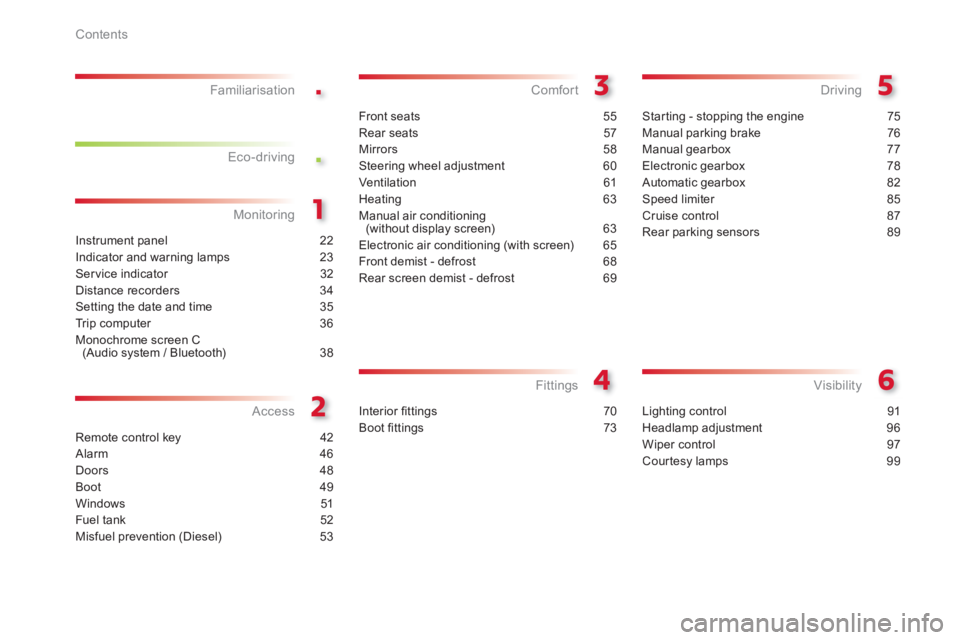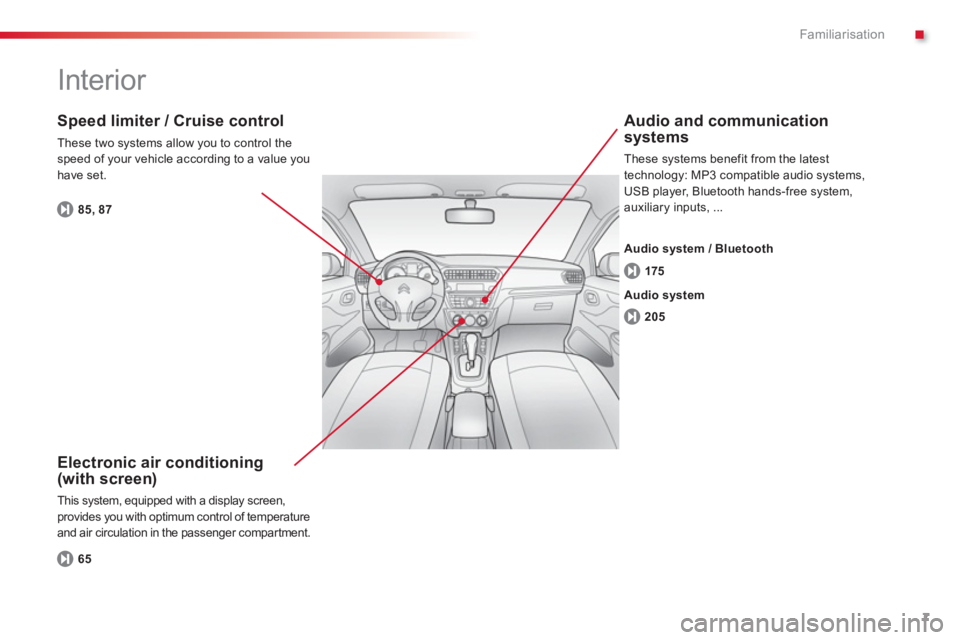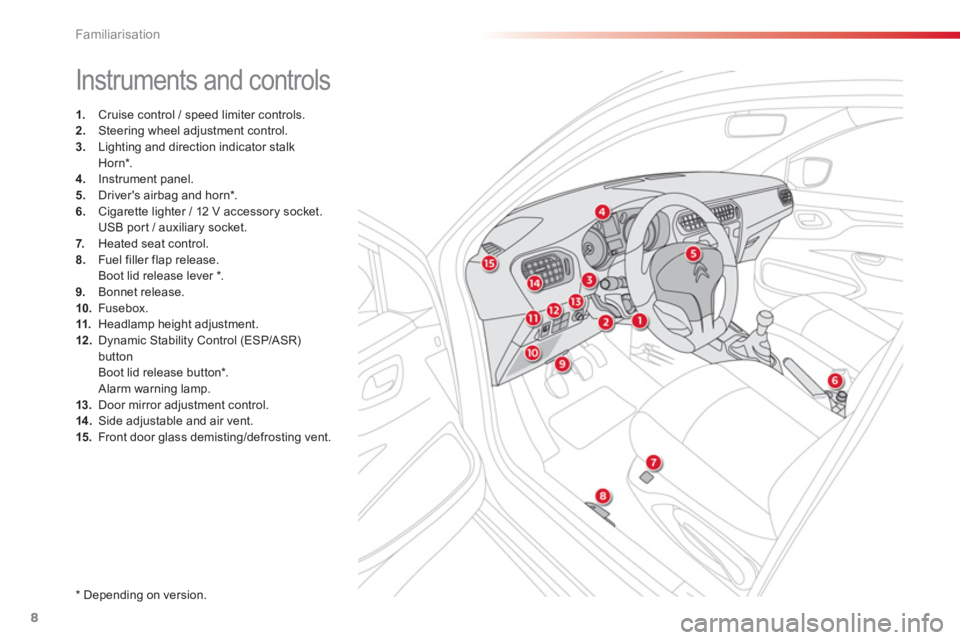cruise control CITROEN C-ELYSÉE 2014 Handbook (in English)
[x] Cancel search | Manufacturer: CITROEN, Model Year: 2014, Model line: C-ELYSÉE, Model: CITROEN C-ELYSÉE 2014Pages: 257, PDF Size: 9.06 MB
Page 4 of 257

.
.
Contents
Instrument panel 22
Indicator and warning lamps 23
Ser vice indicator 32
Distance recorders 34
Setting the date and time 35
Tr i p c o m p u t e r 36
Monochrome screen C(Audio system / Bluetooth) 38
Monitoring Familiarisation
Remote control key 42
Alarm 46
Doors 48
Boot 49
Windows 51
Fuel tank 52
Misfuel prevention (Diesel) 53
Access
Front seats 55
Rear seats 57
Mirrors 58
Steering wheel adjustment 60
Ventilation 61
Heating 63
Manual air conditioning(without display screen) 63
Electronic air conditioning (with screen) 65
Front demist - defrost 68
Rear screen demist - defrost 69
Comfort
Starting - stopping the engine 75
Manual parking brake 76
Manual gearbox 77
Electronic gearbox 78
Automatic gearbox 82
Speed limiter 85
Cruise control 87
Rear parking sensors 89
Driving
Lighting control 91
Headlamp adjustment 96
Wiper control 97
Courtesy lamps 99
Visibility Eco-driving
Interior fi ttings 70
Boot fi ttings 73
Fittings
Page 9 of 257

.
7
Familiarisation
Interior
Electronic air conditioning (with screen)
This system, equipped with a display screen, provides you with optimum control of temperature
and air circulation in the passenger compartment.
Speed limiter / Cruise control
These two systems allow you to control thespeed of your vehicle according to a value you have set.
Audio and communication
systems
These systems benefit from the latest
technology: MP3 compatible audio systems, USB player, Bluetooth hands-free system,
auxiliary inputs, ...
6
5
85, 87
205 17
5
Audio system Audio s
ystem / Bluetooth
Page 10 of 257

8
Familiarisation
Instruments and controls
1.
Cruise control / speed limiter controls. 2.
Steering wheel adjustment control.3.
Lighting and direction indicator stalk
H
orn * . 4.
Instrument panel. 5.
Driver's airbag and horn *
.
6.Cigarette lighter / 12 V accessory socket.
USB por t / auxiliary socket.
7. Heated seat control. 8.Fuel filler flap release.
Boot lid release lever * .9.
Bonnet release. 10.Fusebox.11.
Headlamp height adjustment. 12 .Dynamic Stability Control (ESP/ASR)button
Boot lid release button * .
Alarm warning lamp. 13.Door mirror adjustment control. 14.Side adjustable and air vent. 15. Front door glass demisting/defrosting vent.
*
Dependin
g on version.
Page 21 of 257

.
19
Familiarisation
Driving safely
1.
Selection of limiter mode. 2.Reducing the programmed value. 3.Increasing the programmed value. 4.
Limiter On / Off.
Speed limiter "LIMIT"
85
1.Selection of cruise control mode.
2. Reducing the programmed value.3.
Increasing the programmed value.4.
Cruise control On / Off.
Cruise control "CRUISE"
87 The cruise control or speed limiter mode
appears in the instrument panel when selected.
Display in the instrument
panel
Cruise control
S
peed limiter
The settings must be made with the engine running.To be programmed or activated, the speed of
the vehicle must be above 25 mph (40 km/h),with at least 4thengaged for a manual gearbox (2 nd for an electronically controlled or automatic gearbox).
Page 22 of 257

20
Familiarisation
Eco-driving
Eco-driving is a range of everyday practices that allow the motorist to optimise their fuel consumption and CO2emissions.
Optimise the use of your
gearbox
With a manual gearbox, move off gently,change up without waiting and drive by changing up quite soon.
With an automatic or electronic gearbox, stay in Drive "D"or Auto "A"
, according to the type of gearbox, without pressing theaccelerator pedal heavily or suddenly.
Drive smoothly
Maintain a safe distance between vehicles, use engine braking rather than the brake pedal, and press the accelerator progressively. These practices contribute towards a reduction in fuel consumption and CO2 emissions and also helps reduce the background traffic noise.
If your vehicle has cruise control, make use of the system at speeds above 25 mph (40 km/h) when the traffic is flowing well.
Control the use of your
electrical equipment
Before moving off, if the passenger compartment is too warm, ventilate it byopening the windows and air vents before using the air conditioning.
Above 30 mph (50 km/h), close the windows and leave the air vents open.
Remember to make use of equipment that canhelp keep the temperature in the passenger compartment down (window blinds...).
Switch off the air conditioning as soon as the desired temperature is attained.
Switch off the demisting and defrostingcontrols, if not automatic. Switch off the heated seat as soon as possible.
Switch off the headlamps and foglamp whenthe level of light does not require their use.
Avoid running the engine before moving off,particularly in winter; your vehicle will warmup much faster while driving.
As a passenger, if you avoid connecting your multimedia devices (film, music, videogame...), you will contribute towards limitingthe consumption of electrical energy, and soof fuel.
Disconnect your por table devices beforeleaving the vehicle.
Page 24 of 257

22
Monitoring
Instrument panel for petrol - Diesel
1.
Rev counter (x 1 000 rpm). 2.
Screen. 3.Speedometer (km/h).
A.Electronic or automatic gearbox
information.B.Time.C.Range (km) or
Tr i p d i s t a n c e r e c o r d e r.
D. Fuel gauge.E.
Ser vice indicator (km) then,
total distance recorder.
These two
functions are displayedsuccessively when switching on the ignitionF.Speed limiter or cruise control settings.
4.Reminder of service information
Reset the selected function to zero (trip
distance recorder or ser vice indicator)
Adjust the time.
Dials
Screen
Page 89 of 257

87
5
Driving
Cruise control
speed of the vehicle at the value programmed
by the driver, without any action on the
accelerator pedal.
The cruise control is switched on
manually: it
requires a minimum vehicle speed of 25 mph (40 km/h), as well as the engagement of:
-
fourth gear on a manual gearbox,
- second gear on a or automatic or electronic gearbox, in sequential mode,
- position A
on an electronic gearbox or position D
on an automatic gearbox.
Th
e cruise control is switched off
manually for by pressing the brake or clutch pedal or
on triggering of the ESP system for safety reasons.
It is possible to exceed the programmed speed
temporarily by pressing the accelerator pedal.
To return to the programmed speed, simply
release the accelerator pedal.
Switching off the ignition cancels any programmed speed value. The controls o
f this system are grouped
together on stalk A.
1.Cruise control mode selection thumb wheel.
2. Value decrease button.3.
Value increase button.4.
Cruise control off/resume button.
Steering mounted controls
The cruise control cannot, in any circumstances, replace the need to respect speed limits, nor can it replace the need for vigilance and responsibilityon the par t of the driver. The pro
grammed information is grouped
together in the instrument panel screen.
5. Cruise control off/resume indication.
6. Cruise control mode selection indication. 7. Programmed speed value.
Displays in the instrument panel
Page 90 of 257

88
Driving
�) Turn thumb wheel 1to the "CRUISE"position: the cruise control mode
i
s selected but is not switched on(PAUSE).
Programming
You can then change the programmed speed using buttons 2 and 3:- by + or - 1 mph (km/h) = shor t press,
- by + or - 5 mph (km/h) = long press,
- in steps of + or - 5 mph (km/h) = maintained press.
When the cruise control is switched on, be careful if you maintain the pressure on one of the programmed speed changing buttons: this may result in a very rapid change in the speed of your vehicle.
Do not use the cruise control on slippery roads or in heavy traffic. On a steep descent, the cruise control will not be able to prevent the vehiclefrom exceeding the programmed speed.
To a v o i d a ny risk of jamming of the pedals:
- ensure that the mat is positioned correctly,
- never fit one mat on top of another.
In the event o
f a cruise control malfunction,
the speed is cleared resulting in flashing of the
dashes. Have it checked by a CITROËN dealer
or a qualified workshop.
Operating fault
Leavin
g cruise control mode
�)Turn thumb wheel 1 to the "0"position: the cruise control mode isdeselected. The display returns to the distance recorder.
Exceeding the programmed speed
Intentional or unintentional exceeding of the programmed speed results
in flashing of this speed in the screen.
Return to the programmed speed, by means of intentional or unintentional
deceleration of the vehicle, automatically cancels the flashing of the speed.
�)Set the programmed speed byaccelerating to the required speed,
then press button 2 or 3
(e.g.: 70 mph(11 0 k m / h)).
�)Switch off the cruise control by pressing button 4
: the screenconfirms that it has been switched off (PAUSE).
�)Switch the cruise control back on by pressing button 4again.
Page 156 of 257

154
Practical information
Accessories
A wide range of accessories and genuine par ts is available from the CITROËN dealer network.
These accessories and par ts have been tested and approved for reliability and safety.
They are all adapted to your vehicle and benefit from CITROËN's recommendation and warranty.
"Comfort":
door deflectors, side blinds and rear screen blind, smoker kit, boot dividers, coat hanger,
armrest, insulated module, reading lamp, cruise control, boot storage, front and rear parkingsensors, glove box lid...
"Transport solutions":
towbars, towbar harnesses, canoe carrier, roof bars, bicycle carrier on towbar, bicycle carrier
on roof bars, ski carrier, roof boxes, carrier for roof bars....
"Styling":
gear lever knob, spoiler, parking brake lever
grip, spoiler, alloy wheels, foglamp trims,chromed mirror shells, aluminium footrest,chrome exhaust tailpipes, stickers, door sill
finishers, badge, wheel trims, front spoiler...
"Security and safety" :
wheel security bolts, child seats, breathalyzer, first aid kit, warning triangle, high visibility vest, snow chains, non-slip covers, foglamp kit...
Tow bar, which mst be fitted byCITROËN dealer or a qualified workshop.
Advice on care and maintenance
Recommendations on the care and maintenance your vehicle are given in theservicing booklet.
Page 158 of 257

156
Practical information
Mats Removable carpet protection.
When
fitting the mat for the first time, on the
driver's side use only the fixings provided in the
wallet attached.
The other mats are simply placed on the carpet.
Fitting
Removal
Refitting
To a v o i d a ny risk of jamming of the pedals:
- only use mats which are suited tothe fixings already present in thevehicle; these fixings must be used,
- never fit one mat on top of another.
The use of mats not approved by CITROËN may inter fere with access tothe pedals and hinder the operation of the cruise control / speed limiter.
To remove the mat on the driver's side: �) move the seat as far back as possible, �)
unclip the fixings,�)
remove the mat.
T
o refit the mat on the driver's side: �)position the mat correctly, �)refit the fixings by pressing, �)check that the mat is secured correctly.